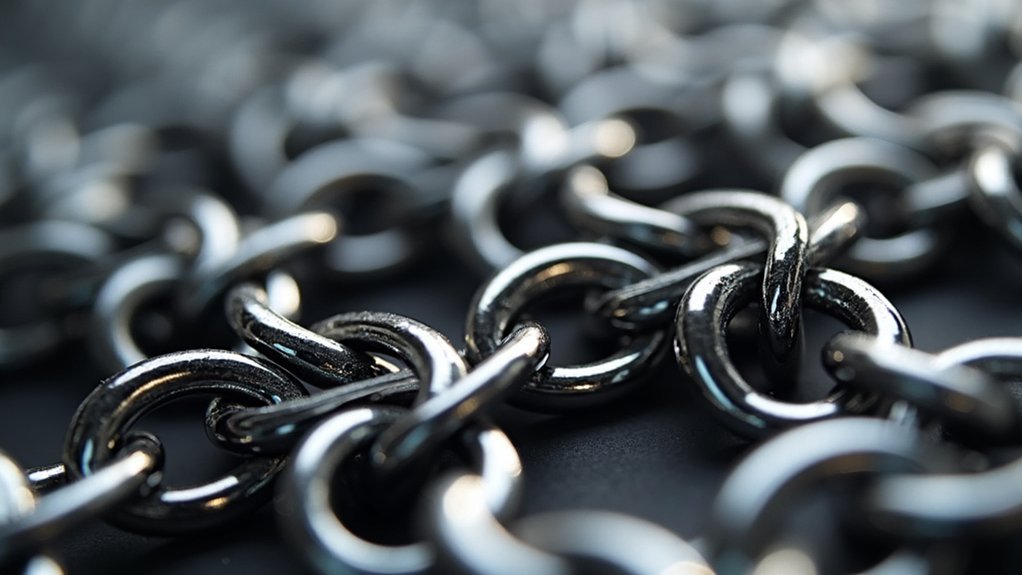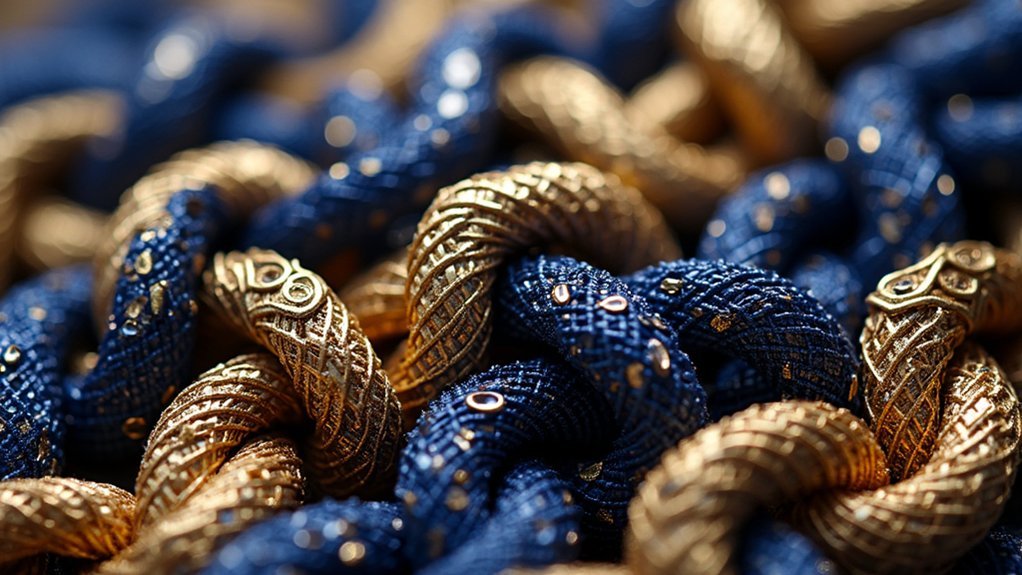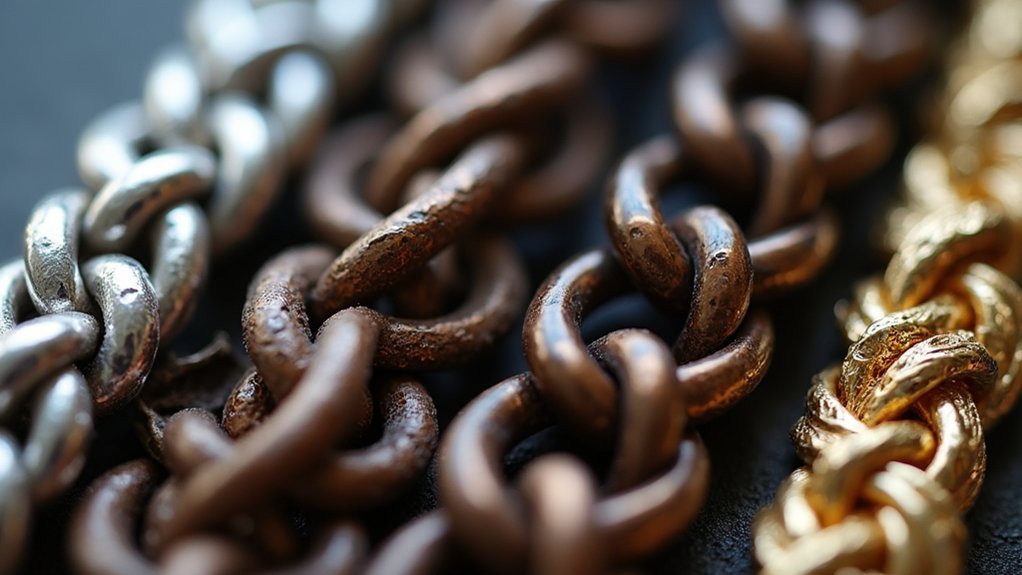You’ll master chainmail crafting by focusing on three essential European weave patterns. The European 4-in-1 weave forms your foundation, connecting four closed rings to one open ring with consistent tension. The 6-in-1 variation offers enhanced density and visual impact, requiring rings with a 4.25 aspect ratio minimum. Byzantine weaves create elegant interlocking loops with 3.2-3.5 aspect ratios, perfect for both armor and jewelry. These patterns will reveal advanced techniques and stunning designs.
European 4-in-1 Weave Pattern and Construction

Four interlocked rings connected by a single central ring form the foundation of the European 4-in-1 weave pattern, one of chainmail’s most versatile and historically significant designs.
You’ll create this chain mail by sliding four closed jump rings onto one open ring, then closing it securely. Continue building rows and columns by connecting each new open ring to the proper sequence of existing rings, maintaining consistent tension throughout your work.
Avoid common construction errors like overstretching rings or incomplete closures that’ll weaken your piece. Some crafters prefer using larger rings for easier handling during initial practice sessions.
Once you’ve completed weaving, inspect every connection for integrity, clean away any debris, and consider applying protective coating for enhanced durability and longevity.
European 6-in-1 Weave Technique and Applications
The European 6-in-1 weave technique elevates your chainmail crafting by connecting six closed jump rings to a single open ring, creating a substantially denser and more protective structure than its 4-in-1 counterpart.
You’ll notice the layered appearance provides enhanced defense and visual impact, making it perfect for armor and decorative pieces.
To succeed with this chain pattern, you’ll need rings with a minimum aspect ratio of 4.25, ensuring proper fit and structural integrity. The inner diameter calculations become vital when opening and closing rings for precise alignment.
Historical reenactment enthusiasts prefer this weave for its authenticity and strength. You can also create stunning jewelry pieces using this versatile technique.
Mastering 6-in-1 represents significant progression in your chainmail skills, requiring more precise handling than simpler weaves.
Byzantine and Persian Weave Variations

Two sophisticated weave patterns—Byzantine and Persian—will transform your chainmail crafting into an art form that balances structural integrity with visual elegance.
The Byzantine weave creates interlocking ring loops requiring an aspect ratio between 3.2 and 3.5 for ideal results. You’ll find its distinct pattern perfect for both jewelry and armor applications.
Persian weave variations offer increased complexity and unique textures. Half Persian 3-in-1 needs a minimum aspect ratio of 3.9, while 4-in-1 requires 4.5.
The Full Persian 6-in-1 demands a strict 5.5 aspect ratio to maintain its structured appearance.
Mastering these variations enhances your skill set and enables you to create intricate designs that are both functional and visually stunning for various chainmail projects.
Frequently Asked Questions
What Tools and Materials Are Needed to Start Making European Chain Weaves?
You’ll need jump rings in various sizes, two flat-nose pliers for opening and closing rings, and optionally ring-cutting pliers. Start with copper or aluminum rings since they’re affordable and easy to work with while you’re learning basic techniques.
How Long Does It Typically Take to Complete a Basic Chain Weave Project?
You’ll typically spend 2-4 hours completing a basic chain weave bracelet as a beginner. Simple projects like keychains take 30-60 minutes, while complex necklaces can require 6-10 hours depending on your skill level.
What Are the Cost Differences Between Various Metals Used in Chain Weaving?
You’ll find copper’s cheapest at $3-5 per pound, while silver costs $800-1000 per pound. Stainless steel offers middle ground at $2-4 per pound. Gold’s most expensive, reaching $25,000+ per pound for your projects.
Can European Chain Weave Patterns Be Machine-Made or Only Handcrafted?
You’ll find most European chain weave patterns can be machine-made using specialized equipment, though intricate designs like Byzantine or Persian weaves often require handcrafting for proper ring closure and pattern integrity.
What Safety Precautions Should Beginners Follow When Working With Chain Weave Materials?
You should wear safety glasses and cut-resistant gloves when handling metal rings. Keep your workspace organized to prevent tripping. Don’t rush – work slowly until you’ve mastered proper techniques and developed muscle memory.
In Summary
You’ve now explored three fundamental European chain weave patterns that’ll elevate your jewelry-making skills. The 4-in-1 weave gives you solid foundation techniques, while the 6-in-1 pattern offers enhanced durability for statement pieces. Byzantine and Persian variations add sophisticated texture and visual interest to your designs. Master these core weaves, and you’ll have versatile techniques that work across different metals and wire gauges for countless creative applications.





Leave a Reply